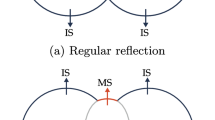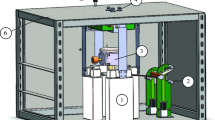Abstract
Shock wave dynamics is a topic with a wide variety of applications ranging from removal of kidney stones to inertial confinement fusion. In reality, the shock front is most often followed by a decay in flow properties, and therefore it is of interest to better understand shock dynamic events for these situations. Thus, an experimental facility that can provide results that are accurate, highly controlled, affordable and with a quick turn-around time are needed. Here, we present the design of an exploding wire system that can be coupled to either a two-dimensional or a three-dimensional test section to provide the user with a multitude of settings to study shock dynamics emanating from shock waves with decaying flow properties behind the shock front. Schlieren photographs taken with an ultra-high speed camera are also presented to show that the exploding wire system functions as intended in both two- and three-dimensional setups.








Similar content being viewed by others
References
Lingeman J, Kim S, Kuo R, McAteer J, Evan A (2003) Shockwave lithotripsy: Anecdotes and insights. J Endourol 17(9):687–693
Lindl J, Landen O, Edwards J, Moses E (2014) NIC Team: Review of the national ignition campaign 2009–2012. Phys Plasmas 21:014501
Anderson JJ (1990) Modern compressible flow: With historical perspective. McGraw-Hill, New York
Eliasson V, Apazidis N, Tillmark N (2007) Controlling the form of strong converging shocks by means of disturbances. Shock Waves 17:29–42
Eliasson V, Tillmark N, Szeri AJ, Apazidis N (2007) Light emission during shock wave focusing in air and argon. Phys Fluids 19:106106
Apazidis N, Eliasson V (2019) Shock focusing phenomena. Springer International Publishing
McGrath J (1966) Exploding wire research 1774-1963. Technical report, NRL Memorandum Report 1698, US Naval Research Laboratory
Nairne E (1774) VII. Electrical experiments by Mr. Edward Nairne, of London, mathematical instrument-maker, made with a machine of his own workmanship, a description of which is prefixed. Phil Trans 64:79–89
Blackmore J (1972) Ernst Mach; his work, life, and influence. University of California Press, Los Angeles
Toepler M (1898) Beobachtung von metalldampfschichtung bei electrischer drahtzerstäubung. Ann Phys 65:873–876
Anderson J (1920) The spectrum of electrically exploded wires. Astrophys J 51:37–48
Anderson J (1922) The spectral energy distribution and opacity of wire explosion vapors. In: Proceedings of the National Academy of Sciences of the United States of America, vol 8, pp 231–232
Anderson J (1934) Electrically exploded wires. In: International Critical Tables. McGraw-Hill, New York
Sakurai A (1959) Chapter: on the propagation of cylindrical shock waves. In: Exploding wires. Plenum Press, New York
Higashino F, Henderson L, Shimizu F (1991) Experiments on the interaction of a pair of cylindrical weak blast waves in air. Shock Waves 1(4):275–284
Apazidis N, Lesser M, Tillmark N, Johansson B (2002) An experimental and theoretical study of converging polygonal shock waves. Shock Waves 12:39–58
Fedotov A, Grinenko A, Efimov S, Krasik Y (2007) Generation of cylindrically symmetric converging shock waves by underwater electrical explosion of wire array. Appl Phys Lett 90(20):201502–3
Efimov S, Fedotov A, Gleizer S, Gurovich V, Bazalitski G, Krasik Y (2008) Characterization of converging shock waves generated by underwater electrical wire array explosion. Physics of Plasmas 15:112703–5
Gilburd L, Efimov S, Fedotov Gefen A, Gurovich V, Bazalitski G, Antonov O, Krasik Y (2012) Modified wire array underwater electrical explosion. Laser Particle Beams 30(02):215–224
Krasik Y, Fedotov A, Sheftman D, Efimov S, Sayapin A, Gurovich V, Veksler D, Bazalitski G, Gleizer S, Grinenko A, Oreshkin V (2010) Underwater electrical wire explosion. Plasma Sour Sci Technol 19(3):034020–9
Krasik Y, Grinenko A, Sayapin A, Efimov S, Fedotov A, Gurovich V, Oreshkin V (2008) Underwater electrical wire explosion and its applications. IEEE Trans Plasma Sci 36(2):423– 434
Veksler D, Sayapin A, Efimov S, Krasik Y (2008) Characterization of different wire configurations in underwater electrical explosion. IEEE Trans Plasma Sci 37(1):88–98
Lakhani E (2018) Design of exploding wire system. Master’s thesis, University of California San Diego
Beg F High Energy Density Physics Group at UC San Diego. http://fbeg.ucsd.edu/
Wang C, Eliasson V (2012) Shock wave focusing in water inside convergent structures. Int J Multiphys 6:267–282
Acknowledgements
This study was partially supported by the US Air Force Research Laboratory under grant No. FA8651-17-1-004 and the National Science Foundation under grant number CBET-1803592. VE wants to thank Mr. J. Gross, Mr. F. Zigunov and Dr. A. Kuthi for help with the first exploding wire setup that lead to this one.
Author information
Authors and Affiliations
Corresponding author
Ethics declarations
Conflict of interests
All authors state that there are no conflicts of interest.
Additional information
Publisher’s Note
Springer Nature remains neutral with regard to jurisdictional claims in published maps and institutional affiliations.
This study was partially supported by the US Air Force Research Laboratory under grant No. FA8651-17-1-004 and the National Science Foundation under grant number CBET-1803592.
Rights and permissions
About this article
Cite this article
Mellor, W., Lakhani, E., Valenzuela, J. et al. Design of a Multiple Exploding Wire Setup to Study Shock Wave Dynamics. Exp Tech 44, 241–248 (2020). https://doi.org/10.1007/s40799-019-00354-8
Received:
Accepted:
Published:
Issue Date:
DOI: https://doi.org/10.1007/s40799-019-00354-8




